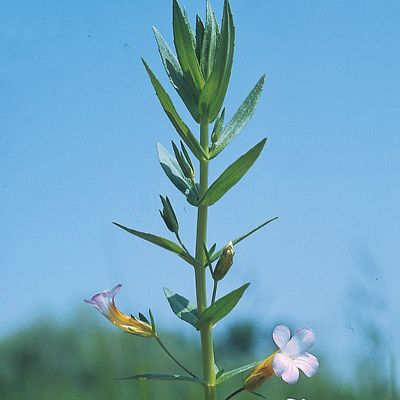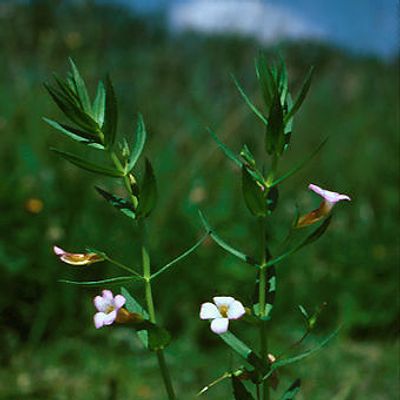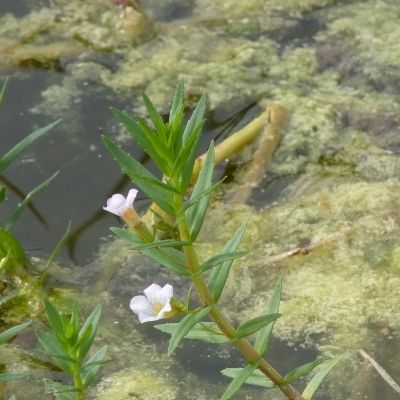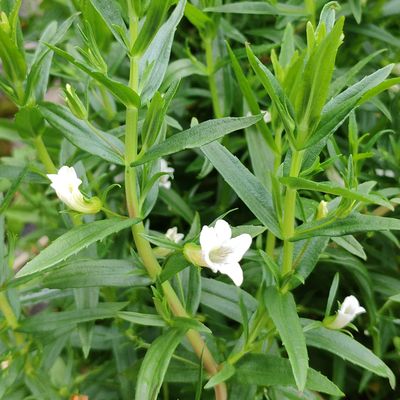Gratiola officinalis L.
1021920
Species
ISFS : 193000
Checklist : 1021920
ISFS : 193000
Checklist : 1021920
Contains :
Synthesis
Species description (© Flora Helvetica 2018)
15-30 cm hoch, einfach oder verzweigt, kahl. Blätter gegenständig, schmal-lanzettlich, fein und scharf gezähnt, sitzend und teilweise umfassend. Blüten lang gestielt, einzeln in den Blattwinkeln. Krone blassrosa, mit gelber Röhre, weit offen-zweilippig, innen bärtig, ca. 1,5 cm lang. Kelch am Grund mit 2 lanzettlichen Vorblättern. Fruchtkapsel mit 4 Klappen aufspringend.Flowering period (© Flora Helvetica 2018)
7-8Habitat and distribution inside Switzerland (© Flora Helvetica 2018)
Gräben, Teiche, Flachmoore / kollin-montan / TI, vereinzelt MWorld distribution (© Flora Helvetica 2018)
EurasiatischEcological indicator (© Landolt & al. 2010)
4+w+43+344.g.2n=32Status
IUCN status
VulnerableNational Priority
4 - weak national priorityInternational responsibility
1 - weakConservation
Threats
Sukzession; fehlende Dynamik, welche offene Stellen in Riedgebieten schafft (Überschwemmungen, extensive Beweidung, Befahren, Tritt, etc.)
Düngung, Eutrophierung
Konkurrenz, invasive Arten wie Goldruten und Adlerfarn
Nutzungsänderungen
Austrocknung, Entwässerung, Meliorationen
Verbuschung, Beschattung
Beweidung, Tritt, Erosion
Weg-, Strassenbau, Unterhalt, Überbauung
Distribution map
Habitat and distribution inside Switzerland
TI, vereinzelt MWorld distribution
EurasiatischEcology
Life form
Geophyte
Habitats
Milieux Phytosuisse (© Prunier et al. 2017)
Habitats © Delarze & al. 2015
 | 2.3.1 - Pfeifengraswiese (Molinion) |
bold
Dominant species, influencing the appearance of the habitat
 Character species
Character species
 Less strictly linked to a specific habitat
Less strictly linked to a specific habitat
Ecological indicator values by © Landolt & al. (2010)
| Soil factors | Climatic factors | Salinity tolerance | |||
|---|---|---|---|---|---|
| Humidity Value H | 4+w+ | Light Value L | 3 | Salinity Index | 1 |
| Reaction Value R | 4 | Temperature factor T | 4 | ||
| Nutriments value N | 3 | Continentality K | 4 | ||
- Ecological values legend
Humidity Value H 1 very dry 1+ dry 2 moderatly dry 2+ moist 3 medium wet 3+ wet 4 very wet 4+ soggy 5 submerged or underwater f plants living in running water u mostly submerged plants v partly submerged, partly floating plants w humidity moderately variable (± scale of 1-2) w+ highly variable humidity (scale exceeding ± 2) Reaction Value R 1 Very acid (pH 2.5-5.5) 2 acid (pH 3.5-6.5) 3 lightly acid to neutral (pH 4.5-7.5) 4 neutral to basic (pH 5.5-8.5) 5 basic (pH 6-5 -> 8.5 Nutriments value N 1 very low in nutrients 2 low in nutriments 3 medium-poor to medium-rich in nutrients 4 rich in nutriments 5 very rich in nutriments Salinity tolerance 1 halotolerant 3 halophyle Light Value L 1 very shady 2 shady 3 lighted areas 4 luminous 5 highly luminous Temperature factor T 1 alpine to nival stages (from the treeline to the snowline) 1+ suprasubalpine and upper subalpine levels (pine and larch forests) 2 subalpine level (coniferous forests without beeches up to the upper limit of spruces) 2+ lower subalpine and upper mountain stages 3 mountain level (beech and silver fir forests, in the central Alps Scots pine forests) 3+ lower mountain and upper hill levels 4 hill level (mixed deciduous oak forests) 4+ hot places, hill level 5 very hot places, hill level (only in the hottest places, typical of southern Europe) Continentality K 1 Atlantic (high air humidity, very low temperature variations, mild winters) 2 Sub-Atlantic (high air humidity, low temperature variations, relatively mild winters) 3 sub-Atlantic to subcontinental (average air humidity, moderately variable temperature, slightly low winter temperatures) 4 subcontinental (low air humidity, large temperature variations, rather cold winters) 5 continental (very low air humidity, very large temperature variations, cold winters)
Water dependency
| Rivers | 1 - Secondary habitat |
| Calm water | 1 - Secondary habitat |
| Ground water | 0 - No link |
Nomenclature
Accepted Name (Checklist 2017)
Gratiola officinalis L.
Vernacular name
Deutscher Name :
GnadenkrautNom français :
Gratiole officinaleNome italiano :
GraziellaMatch with other reference books
| Relation | Nom | Book | No |
|---|---|---|---|
| = | Gratiola officinalis L. | Checklist 2017 | 193000 |
| = | Gratiola officinalis L. | Flora Helvetica 2001 | 1769 |
| = | Gratiola officinalis L. | Flora Helvetica 2012 | 1656 |
| = | Gratiola officinalis L. | Flora Helvetica 2018 | 1656 |
| = | Gratiola officinalis L. | Index synonymique 1996 | 193000 |
| = | Gratiola officinalis L. | Landolt 1977 | 2601 |
| = | Gratiola officinalis L. | Landolt 1991 | 2109 |
| = | Gratiola officinalis L. | SISF/ISFS 2 | 193000 |
| = | Gratiola officinalis L. | Welten & Sutter 1982 | 1455 |
= The taxon corresponds to the accepted taxon (Checklist 2017)
< The taxon is included in the accepted taxon (Checklist 2017)
> The taxon includes (among others) also the accepted taxon (Checklist 2017)
< The taxon is included in the accepted taxon (Checklist 2017)
> The taxon includes (among others) also the accepted taxon (Checklist 2017)
Status
Native status
-IUCN list of endangered species (© Walter & Gillett 1997) : No
Status on national Red List 2016
IUCN status:
Vulnerable

Additional information
IUCN criteria: C1; C2a(i)
Status on regional Red List 2019
| Biogregraphic regions | Status | IUCN criteria |
|---|---|---|
| Jura (JU) | RE | |
| Mittelland (MP) | EN | C1; C2a(i) |
| Alpennordflanke (NA) | RE | |
| Alpensüdflanke (SA) | VU | C1; C2a(i) |
| Östliche Zentralalpen (EA) | RE | |
| Westliche Zentralalpen (WA) | RE |
- Legend
EX Extinct RE Regionally Extinct CR(PE) Critically Endangered, Probably Extinct CR Critically Endangered EN Endangered VU Vulnerable NT Near Threatened LC Least Concern DD Data Deficient NE Not Evaluated NA Not Applicable
National Priority Species List Status
| National Priority | 4 - weak national priority |
| Need to take action | 2 - |
| International responsibility | 1 - weak |
| Need to monitor populations | 2 - |
Protection status
| International (Bern Convention) | No | |
| GE | total protection | (25.07.2007) |
| TG | total protection | (01.01.2018) |
| Switzerland | -- | |
| VD | total protection | (02.03.2005) |
| TI | total protection | (23.01.2013) |
- Disclaimer
InfoFlora compiles information on protected species as accurately as possible, taking it from the respective cantonal laws. In some cases, however, it was not possible to use the plant names as listed in the original text, but an interpretation of their taxonomy or nomenclature was necessary. The exact meaning of the categories „completely protected“ and „partially protected“ differs among the cantons.
InfoFlora cannot guarantee that the information on the protection status is correct and complete. In case of doubts, we recommend to look up the texts of the respective cantonal law.
Status by sector of activity
| Agriculture-related environmental objectives : | more informations | |
| Forest management environmental objectives : | more informations |
Conservation
Threats and measures
Sukzession; fehlende Dynamik, welche offene Stellen in Riedgebieten schafft (Überschwemmungen, extensive Beweidung, Befahren, Tritt, etc.)
Bestehende, punktuelle Störungen beibehalten
offene, pionierartige Stellen in wechselnassen Riedwiesen gezielt fördern
wissenschaftlich begleitete Versuche mit extensiver Beweidung durch Rinder als Pflegemassnahme durchführen (sofern nicht andere stark gefährdete Arten betroffen sind)
Düngung, Eutrophierung
Pufferzonen vergrössern oder einrichten
Düngeverbot
Konkurrenz, invasive Arten wie Goldruten und Adlerfarn
Invasive Arten früh bekämpfen (evtl. von Hand)
Nutzungsänderungen
Bewirtschaftungsverträge
meist Beibehaltung der gegenwärtigen oder Wiedereinführung der früheren Nutzung
teils extensivieren
Austrocknung, Entwässerung, Meliorationen
Nur «sanfte» Meliorationen
der Austrocknung entgegenwirken
evtl. Aufstau, jedoch wechselfeuchten Charakter beibehalten
Renaturierungsmassnahmen
Verbuschung, Beschattung
Entbuschen
benachbarte, die Bestände beschattende Baumreihen oder Gehölze teilweise auslichten
Beweidung, Tritt, Erosion
Bei zu intensiver Beweidung extensivieren
leichte Beweidung jedoch beibehalten
evtl. lokal einzäunen
Weg-, Strassenbau, Unterhalt, Überbauung
Auf Fundstellen Rücksicht nehmen
anpassen von Projekten bereits bei der Planung








